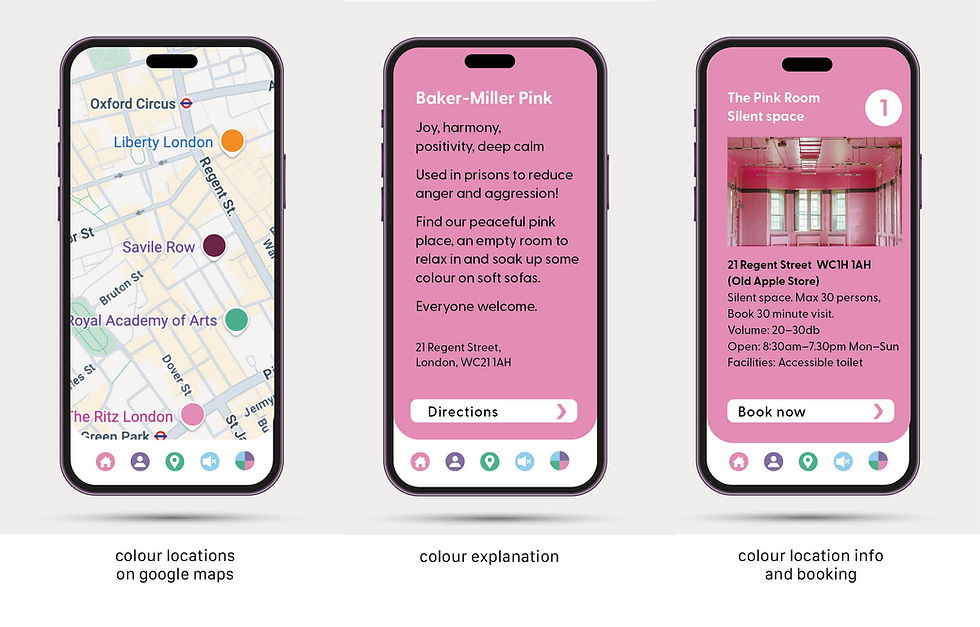Find quiet.
This project explores how to identify and protect quiet spaces in busy cities.




Speculative project for MA Graphic Design to stretch my skills and design thinking
Insight
Life is getting louder. My autistic son finds the chatter of everyday life overwhelming and feels stressed by all the sounds in noisy restaurants and busy streets. My elderly father has hearing loss and finds it difficult to focus on particular sounds, like speech, when there is too much background noise. I recognised the challenges both faced from being overwhelmed by constant noise, was shared by many other people of different ages and backgrounds, and as a result decided to find a solution through design.
Research
Research question: How can graphic design identify and preserve quiet spaces?
I explored the benefits of silence on mental health and productivity, found out about Japanese listening bars, reflected on 90s club chill-out rooms and contemplated different types of silence: is quiet imposed and oppressing or voluntary and restful? I researched ways to represent silence visually, from shushing emojis, silent books and mouthless characters like Miffy to adverts for Apple’s noise cancelling earbuds.
Solutions
-
APP 'Find quiet.' is an app and new Google maps feature which identifies a network of quiet locations in busy cities. This includes existing quiet spaces such as libraries, parks and art galleries.
-
WINDOW STICKER Venues can register as quiet locations and display a ‘quiet here.’ window sticker, proactively attracting people seeking stillness from the hub-bub of city life.
-
NETWORK Users' phones measure decibels linking to back to Google maps, creating a database of sound volume in urban areas, identifying quiet and loud spaces in real time.
-
BADGE A badge is available for people with sound sensitivity to wear which quietly communicates their need for quiet.

Badge for user
Window sticker for quiet venue
Conclusion
Although my initial user focus was for the neurodiverse community, or those with sensory processing disorders, finding quiet would be helpful for many different people and many different reasons. For people with hearing issues, anxiety, stress, tiredness, illness, those seeking space for meditation or worship. Those seeking freedom from visual clutter, from endless messaging and advertising, freedom from high street consumerism and wanting what we cannot have. From those seeking stillness to contemplate or just quiet the mindless chatter. To #Stop. Enter the quiet.




Find colour.
Creating new quiet colour spaces in disused retail buildings
The second aspect to the Find quiet. app project concerned creating new quiet spaces.
Insight
Our rapidly emptying town centres, boarded-up shops and empty retail spaces are creating a rise in anti-social behaviour, a loss of economic prosperity, an absence of community pride and connection. The vacant spaces in our high streets need a new injection of life and a new purpose, one which invites visitors to linger, to readily participate and connect with each other, and with the space itself.
I once saw a freshly-painted art gallery before any paintings been hung and being surrounded by nothing but colour made a lasting impression on me.
Research
I investigated emotional connection to colour and colour therapy theory. I was interested to learn of the use of 'Baker-Miller Pink' in prisons to calm inmates.
Solution
Using the same interface and app design as ‘find quiet.’, the ‘find colour’ app would direct users to the nearest colour experience. These would be located in empty disused retail spaces with everything in just one colour, including soft furnishings, noise cancelling fabrics... users could wear noise cancelling headphones and choose a sound to listen to or just hear nothing. They would feel safe, calm, rested, uncluttered, accepted, welcomed and enjoy temporary escape from the audio and visual noise of a city.
Participation: Users could share their colour memories, writing them on blank postcards to be added to an online database which could be read during a visit. They could feedback on how they felt during their visit.
Conclusion
The opportunity for landlords to open up these spaces for meanwhile use (use whilst vacant), ideally for free, would act as an attractor. For the curious, the hurried and the stressed, those looking for respite, or just to experience something different. Thousands of meters of retail space are boarded up across Britain, providing the opportunity to create colour therapy and sound therapy at the same time would breathe some new experience into the high street. Providing a safe space for people who currently feel unable to cope with loud spaces, recharging them to continue their day out, whilst providing a beautiful antidote to noise, bustle and frenetic energy of shopping areas.
A chance to stop, breathe in some colour and be quiet.



